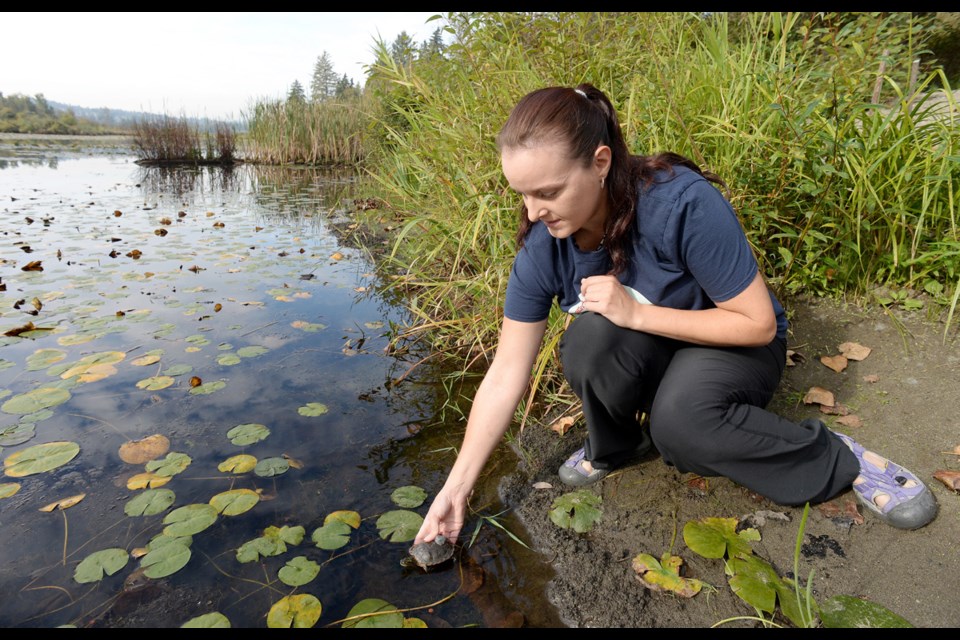The endangered Western painted turtle is the last native freshwater turtle living in B.C., and the largest known population resides at Burnaby Lake. Reporter Jennifer Moreau visits with three women who watch over the city’s protected species.
INTO THE WILD
They were the last of the wee ones.
On Tuesday, three biologists released the four remaining Western painted turtles into Burnaby Lake after the reptiles were rescued from their nesting beach following the CN coal spill in the spring.
The baby turtles were dug up from the sand, some as tiny as a fingertip, and raised in government care till they were large enough not to be swallowed by invasive bullfrogs. Each has a small radio transmitter attached to its shell, so the team can track its movements.
Government biologist Kym Welstead is joined by Aimee Mitchell from the Coastal Painted Turtle Project, and Deanna MacTavish, an SFU student doing her master’s project on the turtles. Welstead has brought her young daughter to help gingerly place the turtles back in the water along the shoreline. The reptiles take to the water quickly but linger a while before disappearing beneath the lily pads.
“It’s really nice to bring them back. It also gives you a lot more confidence in their survivorship,” says Welstead. “I think they love it. It’s unlimited food for them till the winter comes.”
ONLY TWO NESTING SITES
The Western painted turtle is listed as endangered – just one step away from extinction in Canada. Welstead estimates the overall Burnaby Lake population is now at 150, but she would like to see it grow to 300 or 400. There are Western painted turtles at Deer Lake, as well, and they travel along Deer Lake Brook, the one-kilometre waterway connecting to the two lakes.
Burnaby Lake is home to one of two known nesting sites. Welstead won’t disclose the location of the second – all she will say is it’s in the Fraser Valley.
“People poach,” she says. “We’ve had poachers at Deer Lake.”
The turtles face numerous threats: road deaths, trapping, natural predators, and illnesses brought in by other invasive species.
The non-native red-eared slider, introduced to the wild thanks to people dumping them as pets, can bring stomach parasites and respiratory illnesses to the native population.
THE DANGERS OF GENETIC MIXING
All of the 100 rescued Western painted turtles survived and are now back in their natural habitat. However, some additional turtles collected after the spill were hybrids, a genetic mix with the Ontario’s Midland painted turtle. Welstead is confident the Midlands are dumped pets, since there’s no way they could make it across the country on their own. To be sure, the biologists did genetic testing on all of the turtles they recovered, swabbing their faces for DNA samples.
The results showed roughly 30 were hybrids, and some had a genetic profile that was traceable back to New York City. The hybrids went to a rescue centre, and the sick ones were euthanized. Releasing them back in the wild, where they would breed with the native population, was not an option.
“Eventually, you won’t have any native ones. With only two breeding sites in the Fraser Valley, that’s all we have,” Welstead says.
TURTLE SURVIVAL
Overall, Burnaby Lake’s Western painted turtle population is doing well, all things considered.
“I think it’s recovering. I think it probably has declined through time,” Welstead says.
The long-term effects of the coal spill are unknown at this point, and the trio is waiting for a toxicology report from CN.
The coal from the January train derailment is generally considered harmless unless it was mixed with some kind of chemical, which remains to be seen. (CN could not be reached by deadlines).
In the meantime, MacTavish and Mitchell are tracking the turtles’ overwintering patterns, their movements and their survival rates, as well as any impact from the coal spill. (MacTavish’s master’s study should be completed in two to three years.)
Welstead is also hoping people will stop dumping pet turtles in the wild.
“I think this population is going to do well with help,” she says.
Report sightings of Western painted turtles to the Coastal Painted Turtle Project by emailing wptrecovery@gmail.com.



